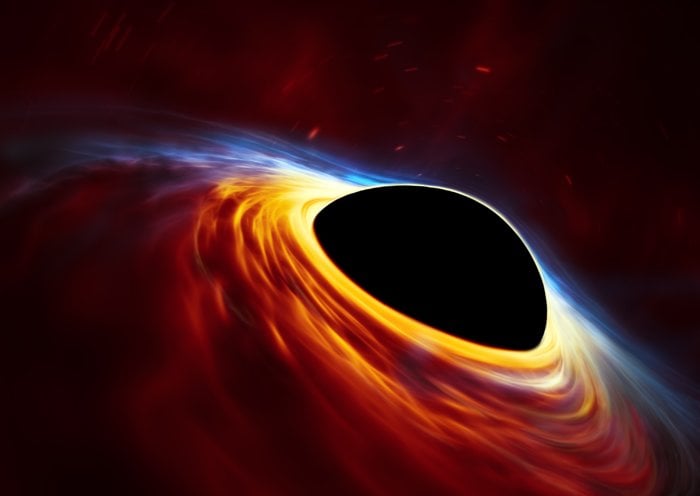Black holes are one of the most awesome and mysterious forces in the Universe. Originally predicted by Einstein's Theory of General Relativity, these points in spacetime are formed when massive stars undergo gravitational collapse at the end of their lives. Despite decades of study and observation, there is still much we don't know about this phenomenon.
For example, scientists are still largely in the dark about how the matter that falls into orbit around a black hole and is gradually fed onto it (accretion disks) behave. Thanks to a recent study, where an international team of researchers conducted the most detailed simulations of a black hole to date, a number of theoretical predictions regarding accretion disks have finally been validated.
The team consisted of computational astrophysicists from the University of Amsterdam's Anton Pannekoek Institute for Astronomy, Northwestern University's Center for Interdisciplinary Exploration & Research in Astrophysics (CIERA), and the University of Oxford. Their research findings appeared in the June 5th issue of the Monthly Notices of the Royal Astronomical Society.
Among their findings, the team confirmed a theory originally put forth in 1975 by James Bardeen and Jacobus Petterson, which has come to be known as the Bardeen-Petterson Effect. In accordance with this theory, the team found that while the outer region of an accretion disk will remain tilted, the disk's inner region will align with its black hole's equator.
To put it simply, just about everything researchers know about black holes has been learned by studying accretion disks. Without these bright rings of gas and dust, it is unlikely that scientists would be able to locate black holes. What's more, a black hole's growth and rotational speed are also dependent on its accretion disk, which makes studying them essential to understanding the evolution and behavior of black holes.
As Alexander Tchekhovskoy, an assistant professor of physics and astronomy from Northwestern University who co-led the research, described it: "Alignment affects how accretion disks torque their black holes. So it affects how a black hole's spin evolves over time and launches outflows that impact the evolution of their host galaxies."
Ever since Bardeen and Petterson proposed their theory, black hole simulations have suffered from a number of issues which have prevented them from determining if this alignment takes place. First of all, when accretion disks approach the Event Horizon, they accelerate to tremendous speeds and move through warped regions of spacetime.
A second issue which complicates matters further is the fact that a black hole's rotation forces space-time to spin around it. Both of these issues require that astrophysicists account for the effects of general relativity, but there remains the issue of magnetic turbulence. This turbulence causes the disk's particles to hold together in a circular shape andeventuallaccrete onto the face of the black hole.
Until now, astrophysicists have not had the computing power to account for all of this. To develop a robust code capable of carrying out simulations that accounted for GR and magnetic turbulence, the team developed a code based on graphical processing units (GPUs). Compared to conventional central processing units (CPUs), GPUs are much more efficient at image processing and computing algorithms that process large swaths of data.
The team also incorporated a method called adaptive mesh refinement, which saves energy by focusing only on specific blocks where movement occurs and adapts accordingly. To illustrate the difference, Tchekhovskoy compared GPUs andCPUSto 1,000 horses vs. 1,000-horsepower Ferrari:
Last, but not least, the team ran their simulation using the Blue Waters supercomputers at the National Center for Supercomputing Applications (NCSA) at the University of Illinois at Urbana-Champaign. What they found was that the while the outer region of a disk may be tiled, the inner region will be aligned with the black hole's equator and a smooth warp will connect them.
In addition to providing closure to a long-standing debate about black holes and their accretion disks, this study also shows have far astrophysics have progressed since the days of Bardeen and Petterson. As Matthew Liska, a researcher summarized:
The team solved the long-standing mystery of the Bardeen-Petterson Effect by thinning the accretion disk to an unprecedented degree and factoring in the magnetized turbulence that causes the disk to accrete. Previous simulations made a substantial simplification by merely approximating the effects of the turbulence.
What's more, previous simulations worked with thinned disks that had a minimum height-to-radius ratio of 0.05, whereas the most interesting effects viewed by Tchekhovskoy and his colleagues occurred once the disk was thinned to 0.03. To their surprise, the team found that even with incredibly thin accretion disks, the black hole still emitted jets of particles and radiation at a portion of the speed of light (aka. relativistic jets).
As Tchekhovskoy explained, this was a rather unexpected find:
With all the recent finds astrophysicists have made concerning black holes and their accretion disks, you might say we are living in the second "Golden Age of Relativity". And it would be no exaggeration to say that the scientific payoffs of all this research could be immense. By understanding how matter behaves under the most extreme conditions, we are getting ever closer to learning how the fundamental forces of the Universe fit together.
Further Reading: Northwestern Now*, MNRAS*
 Universe Today
Universe Today



